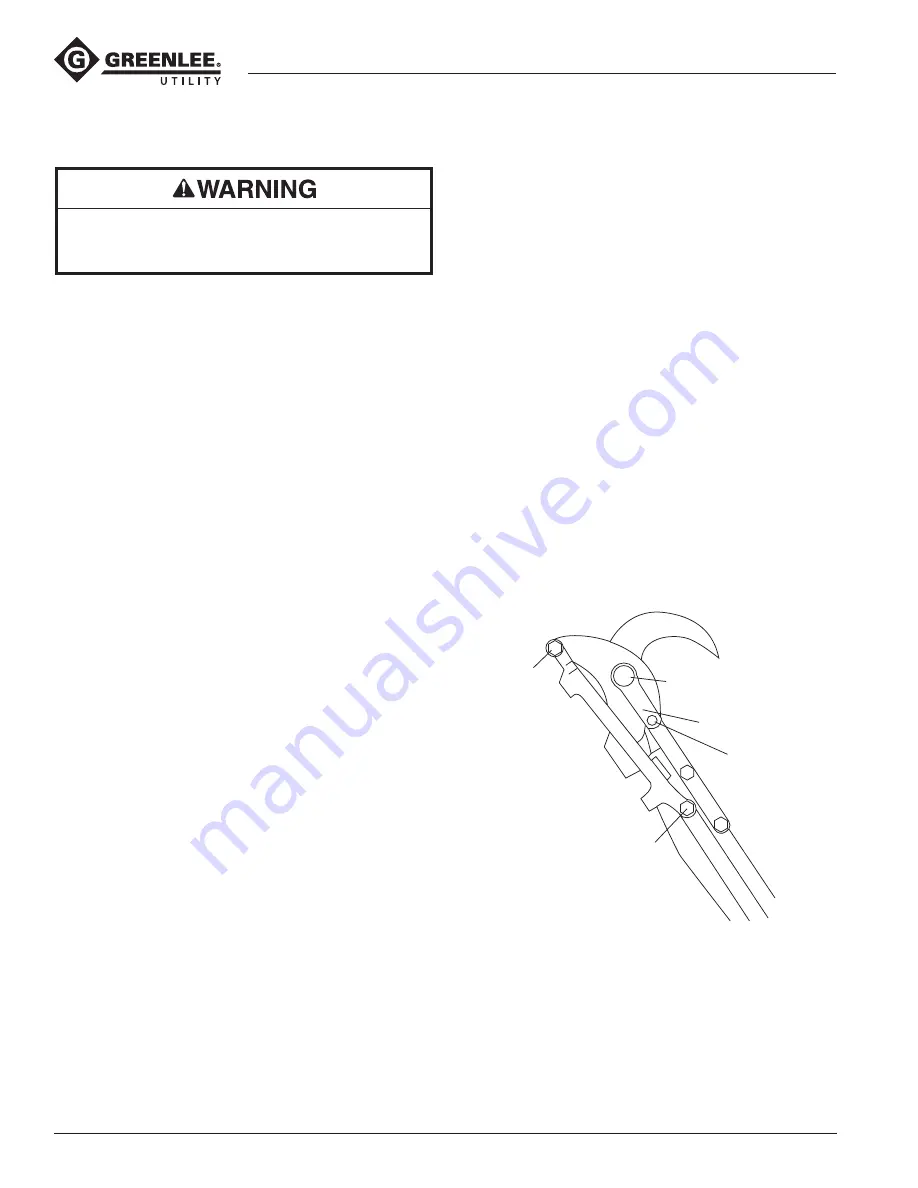
48520 Pruner
Greenlee / A Textron Company
4455 Boeing Dr. • Rockford, IL 61109-2988 USA • 815-397-7070
6
Maintenance
(cont’d)
Blade and Hook Maintenance
Do not dress the blade or inspect, adjust, or
clean tool when it is connected to a power source.
Accidental startup can result in serious injury
Dressing the Cutter Blade and Hook
A buildup of metal, referred to as a wire edge, will form
on the edge of a new blade as it seats across the face
of the hook. This wire edge must be removed several
times, until the blade seats itself to the hook.
Rough and dull edges may form on the cutter blade and
the cutter hook from normal usage. Both components
must be dressed with a pocket whetstone several times
each operating day. This keeps the cutting edges sharp
and prevents them from rolling and chipping.
1. Stop the power source.
2. Use the provided pocket whetstone (50423921) to
remove the wire edge by rubbing the whetstone
back and forth on the blade and hook until the
surface irregularities are smooth and the blade
edge is sharp.
Sharpening the Cutter Blade
When a blade has acquired deep nicks and gouges or
has become too dull to be sharpened with a whetstone,
remove the cutter blade and sharpen it with a fine
metal-cutting file.
1. Disconnect the tool from the power source.
2. Remove the cutter blade from the tool. Refer to
“Cutter Head” in the “Disassembly” section of this
manual.
3. Sharpen the blade with a fine metal-cutting file.
Note: When sharpening with a file, it is impor-
tant to maintain the original shape and contour of
the blade. An equal amount of material must be
removed from all parts of the blade.
Do not
sharpen
the blade to a thin, razor edge. This reduces the
strength and shortens the service life of the blade.
Do not overuse the file. It is not advisable to remove
large amounts of metal from the blade.
4. After the contoured side of the blade has been
sharpened, turn it over so that the flat side is facing
up. Dress the blade with a whetstone just enough to
smooth away any nicks and irregular sharp edges
that may have formed during sharpening of the
contoured side of the blade.
5. Remove any nicks or rough edges on the hook with
a pocket whetstone. The inner curve of the hook
should have a beveled cutting edge. This can be
achieved with the whetstone also. Failure to do this
can ruin a new or sharpened blade.
Tension Adjustment
The tension adjustment should be checked after about
one hour of use on a new cutter. A wearing-in process
takes place during this time and the cutter pivot nut may
need tightening.
The cutter hook and cutter blade must fit together
snugly. If they are too tight, the cutter will not perform
properly. If the fit is too loose, the tool will not cut
cleanly, and damage to the tool may occur.
1. Disconnect the tool from the power source.
2. Remove hex nuts (1), shoulder bolts (2), and guide
roller (3).
3. Remove the #10 cap screw and lock washer (4, 5).
4. Remove the cutter bolt lock (6).
5. Tighten shoulder bolt (7) to a very heavy drag when
the blade is opened or closed. This drag can be
tested manually without hydraulic power. When
heavy drag has been set, loosen shoulder bolt (7)
one-quarter (1/4) turn.
6. Using one wrench on the shoulder bolt (7) and a
second wrench on the nut, tighten the nut. The
tension is correct when a moderate drag is felt when
moving the cutter blade by hand.
1, 2
7
6
4, 5
1, 2, 3


















